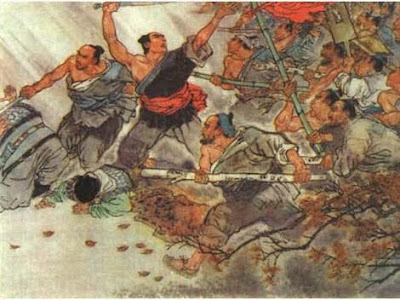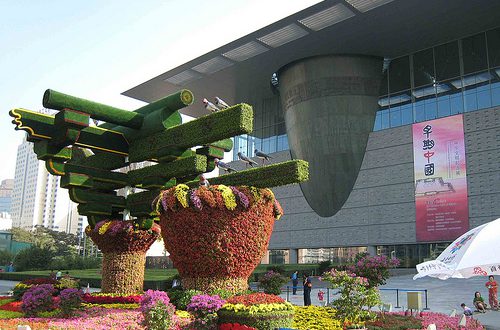Qin Shi Huang was apprehensive about the prospect of death so, according to Shiji, he tried hard to find an elixir that would make him immortal. Hedging his bets, he simultaneously commissioned the building of his mausoleum. The tomb complex was designed as a miniature of the capital city, Xianyang, of the Qin Dynasty, and the terracotta army signified a garrison force to protect this underground empire.
The underground palace symbolized the Xianyang Palace in which the First Emperor lived, and the inner city and outer city of the tomb complex were also imitation of the capital. The terracotta army, symbolizing the real army of the Qin, is located 1.5 km east of the tomb mound. It is estimated that up to 8,000 terracotta warriors and horses will be found in the pits, but so far only about 1,100 have been unearthed. Every figure is different, prompting speculation that they were modelled on real personalities in Qin Shi Huang’s army.
Recruitment Drive
In the early Bronze Age of China warfare was primarily an activity engaged in by members of the male aristocratic elite mounted in chariots and accompanied by foot soldiers. Warriors demonstrated their expertise in ritual ceremony, and gained social prestige by performing in combat, chariot driving and archery competitions.
During the Spring and Autumn period (770-221BC), however, the nature of warfare changed. Aristocratic society and values were in steep decline. Although ritual still played an important role, the final outcome, victory or defeat, was much more important, and war was, as Sun Zi (an ancient military theorist) said, a vital matter of state that could not be neglected by any ruler. Wars lasted much longer and were fought by large armies composed primarily of conscripted peasants.
The Qin Dynasty probably had both a standing army and a conscripted army. The standing army was mainly composed by the aristocrats who were well trained and well equipped. Their weapons, armour, and even the clothes were supplied by the government. The terracotta army buried with the First Emperor was considered to belong to the standing army, and they seemed well-equipped. The conscript army was drafted on a temporary basis (often very temporary!) for warfare. These soldiers prepared their weapons, armour and clothes by themselves or borrowed from the governmental arsenal, according to the bamboo slips unearthed from the Qin tombs at Yunmeng Shuihudi, Hubei Province. Two personal letters were also discovered on the bamboo slips, which were written in the cold winter by two solders to ask for warm clothes from their homes.
Battle Tactics
During the Warring States Era (475-221BC), chariots followed by infantry were still important, but a new element had been adopted from the steppe nomads: cavalry. Horseriding was first developed in east Asia by steppe dwellers in the north-eastern regions of modern China in Eastern Zhou times, but cavalry only seems to have been adopted by the Chinese in the mid 4th century.
A field army was composed of four parts: chariots, infantry, cavalry and archers, as displayed by the terracotta warriors. Cavalry played crucial roles in campaigns of unification under the First Emperor, but judging by the numbers of cavalry horses and men in the warriors’ pits, cavalry still seems to have had a tertiary function in battle, supplementing the main fighting force of infantry and chariots. Interestingly, the Qin cavalry horses don’t have any stirrups to help the rider mount and give him stability in the saddle.
According to one ancient military document, these early cavalry would have acted as scouts or raiders who could devastate an enemy’s formation, destroy his ferries or boundary gates, cut off and burn his supply train and lines of communication, and make sudden strikes at unexpected places, either during a pitched battle or when the opposing armies were on the march.
How to Get Out of a Checkmate
Sun Bin (a grandson of Sun Zi) recommended that a general should split his units of cavalry and chariots into three detachments, one on either flank and one at the rear. He suggested that on flat and easy ground the general should deploy more chariots, but on rugged terrain he should commit more cavalry, and in really precipitous terrain he should use his crossbow men.
Thus by the time of the First Emperor, military specialists had analysed the strength and weakness of the different types of units that composed an army, and the correct deployment of forces in the field of battle depended on the experience and competence of highly skilled generals. Qin forces and Lian Po, a Zhao general, even engaged in a kind of static months-long trench warfare at the battle of Changping in 260 BC. The standoff only ended when the Qin spread rumours and paid bribes, encouraging Zhao to replace the wily Lian with the incompetent Zhao Kuo. Qin thereupon appointed his great general Bai Qi, who scored a crushing victory through a classic manoeuvre. The Qin pretended to flee and then ambushed the pursuing Zhao forces, cutting them off from their lines with 5,000 cavalry so that the Zhao army was split in two and ran out of provision after forty-six days. Bai then massacred the 450,000 Zhao men who surrendered, allowing only the youngest 240 to flee back to the Zhao capital, Handan, to report what had happened.
Tiger Tally
In order to ensure that the generals didn’t abuse their delegated authority, the Qin and its rivals developed a system of tallies that conferred the right to raise forces. These were cast in metal, usually bronze, and often in the shape of a tiger, symbolizing war. They came in two identical parts that were inlaid with inscriptions specifying the number of soldiers the general could raise. On receiving his posting, a general would be given one half of the tally and the ruler would keep the other half. Only when the central authorities sent out the second half and the general could match the two halves together could he legitimately raise the forces listed in the inscription.
Unification
In the fifth and forth century BC Qin, one of seven states in the Warring States Period, began a long process of changing its legal, political, military and social institutions. This process would culminate in successfully uniting all the other rival states into a single polity under the First Emperor.
Shang Yang’s (385-338 BC) innovation played an important role to lay the foundations for Qin’s unification. He started to build up Qin’s military strength. He organized the troops into small ‘responsibility groups’ of perhaps of five or ten, with each member being responsible for reporting crimes committed by his colleagues. One male was taken from each household to form a squad of five, the basic unit in the army, and those soldiers were also held responsible for each other’s safety. If they lost one man, it was their duty to capture the head of an enemy in exchange.
It is probable that the Qin established its conscript army at this time. Another reform created by Shang Yang is setting up a system of seventeen ranks or grades (jue). Rank was awarded for success in battle according to the number of enemy soldiers killed. This proved to be an effective motivator for the Qin soldiers, who displayed great bravery in the battle field to achieve their individual merit.
Qin Shihuang was born at the right time. With the ministerial talents of Li Si, complemented by the military capabilities of the general Meng Tian, Qin grew more prosperous and increased its offensives against the rival kingdoms. He adopted Li Si’s military strategy, known as “a silkworm devouring a mulberry leaf” and eventually conquered the other six states and unified China in 221BC.




